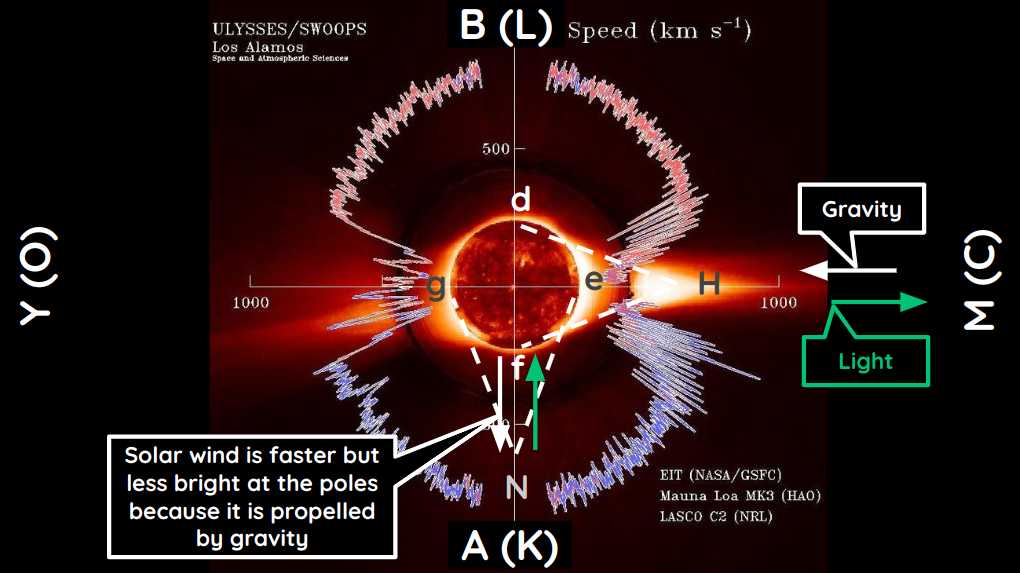The Motion of the Fire-Aether
Table of Contents
76. The motion of the fire-aether while moving among the air-aether globules
The fire-aether particles move among the air-aether globules. They have:
- straight motion:
- from poles
ABto the Sun, and - from the Sun to the ecliptic
YM
- from poles
- circular motion around the poles common to the whole sky
AMBY

The fire-aether also constantly changes the shapes of its small particles, so that they can accurately fill all the small angles that they pass through.
Hence, its force, being greatly divided, becomes weaker.
Each of its small particles:
- follows the motions of the neighboring air-aether globules
- are always ready to exit those narrow spaces where it is forced into such oblique motions, and to proceed straight towards any parts.
The fire-aether accumulated in the sun’s body has very great force there due to the agreement of all its parts in the same very rapid motions.
They spend all their forces in propelling the surrounding air-aether globules here and there.
77. How the Sun’s light spreads not only towards the ecliptic but also towards the poles.
The fire-aether particles contribute to that action called light.
- That action spreads not only towards the ecliptic but also towards the poles in all directions.
We assume there is some space in H filled only with the fire-aether.
- Yet this space is large enough to accommodate one or more of the air-aether globules.
If so, then at the same moment, all the globules contained in the cone dHf would move in.
78. How It Spreads Along the Ecliptic
This spreading has already been demonstrated.
- The small spheres within the triangle whose base is a semicircle of the solar ecliptic will move out, even if no light (action) of the fire-aether has been observed.
The operation of this fire-aether will make this whole operation within the cone clearer.
The fire-aether that forms the body of the Sun propels the following small air-aether spheres towards H:
- those that are at the ecliptic
e - those that are at the poles
dandf - all that are in the cone
dHf.

The fire-aether moves with equal force towards e, d, and f and other intermediate parts.
The part that is now at H tends towards C. From there, it returns through K and L towards S as if in a circle.
Therefore, it does not prevent those small spheres from approaching H.
By their approach, the space that was previously there increases the Sun’s body*, and is filled with the fire-aether flowing there from the centers K, L and similar points.
Superphysics Note
79. The motion of one small body can easily move others, even if they are very far away
All motion tends in a straight line.
The highly agitated matter existing in H tends more to exit from there than to remain.
The narrower the space it occupies, the more it is compelled to deflect its motions.
This is why:
- the motion of a very tiny body can simultaneously move other bodies spread over very large spaces
- the light (action) of the sun and the most remote stars reaches the Earth in a very short time.
80. How the light of the sun tends towards the poles
If space N is filled only with the fire-aether [meaning it had zero air-aether], then all the small air-aether spheres within the cone gNe, must be driven by the fire-aether in the Sun.
It will move the air-aether spheres with great force from d towards f, and at the same time towards the entire hemisphere efg.
This is even if the air-aether spheres might have no inherent tendency for that motion. Nor do they resist it, just as the fire-aether in N is itself very ready to move towards S.
- Once at
Sthey will fill that space. - The motion of the small spheres of the concave hemisphere
efgtowardsNwill increase the Sun’s body.
Thus, at the same time:
- the small air-aether spheres move from
StowardsN - the fire-aether move from
NtowardsS, as if in opposite motions
The fire-aether passes only through those very narrow gaps which the small air-aether spheres do not fill.
- This is why its motion is not impeded by the air-aether.
- This is similar to sand clocks wherein the sand falling from the upper part does not prevent the air from ascending from the lower part through the spaces between the grains of sand.
81. Is the force of the fire-aether equal at the poles and the ecliptic?
Are the small spheres in the cone efg driven with as much force towards N by the fire-aether of the Sun alone, as the small spheres fgd are driven towards H?
This does not seem to be the case if H and N are equidistant from S.
But the distance is less towards the poles that towards the ecliptic.
Thus at most, this force can be equal when the proportion between the lines HS and NS is the same as between MS and AS.
This can only be decided by experiments on comets that are first seen in the ecliptic, then later seen near one of the poles, and then again in the ecliptic.
Considering its distance, it can be estimated whether its light (which I will show below to be from the Sun) appears greater towards the ecliptic than towards the pole, all else being equal.